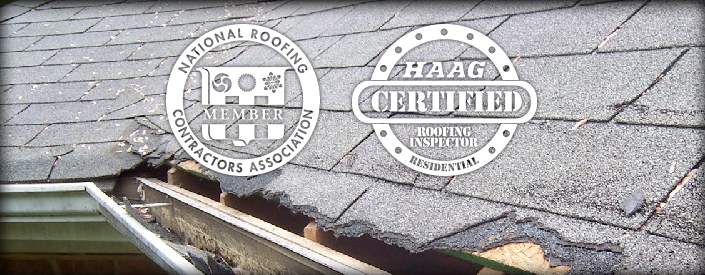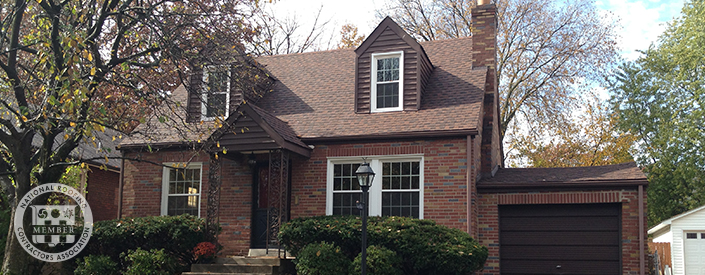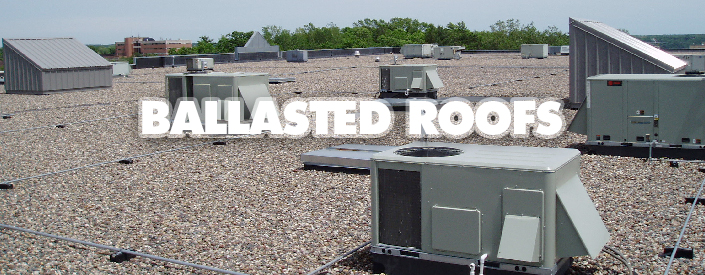Residential Roofing
Property owners most often find themselves at a huge disadvantage trying to speak the language of insurance adjustors and restoration contractors are accustomed to using on an every day occasion. At ATRS we believe an informed roofing customer is a good roofing customer. That’s why we have spent the time working with the industries top manufacturers and suppliers to provide you with resources that will help you understand our processes and specific industry terminology. Click for a GAF Roofing Glossary of Roofing Terms.
As in all industries if you know what to look for, there are always tell-tell signs of failure. Our team of field agents have put together a list of pre-failure indicators that are easy to spot and monitor. Addressing problems early on will help stop additional and unnecessary future damage to your home before it happens.
Roofing Pre-Failure Indicators
• Inspect for repeated formation of ice dams along roof’s edge or in gutters.
• Look for curling edges or dark stains on asphalt shingles
• Take a trip to the attic with a flashlight and look for staining on the underside of the roof deck
• Check your gutters for the collection of loose granules from worn shingles.
• Always survey your property after a severe storm has passed for dis-located Shingles or tiles as well as do a visual check, perhaps with a pair of binoculars, for cracked or missing shingles or roof tiles.
• Always Inspect for loose or sometimes missing metal flashing around chimneys and vents.(especially after a storm)
• Streaking along exterior walls of your home
• Inspect for excessive growth of moss on roof shingles
At ATRS we encourage homeowners to be proactive.
There’s a lot of wisdom in: “An ounce of prevention is worth a pound of cure.” We didn’t say it, Benjamin Franklin did and we think he was a pretty smart fellow!
Roofing Failure Photographs
To see actual photographs of some of the commonly referred to roofing failures visit GAF, our roofing manufacturer’s web page or read on for a list of common problems with probable causes
LIST OF PROBABLE CAUSES
Leakage in Attic After Wind-Driven Rain
Possible cause: Leaky or inadequate shingle underlayment or deteriorated flashing
Leakage in Attic After Ice Build-Up
Possible cause: Inadequate shingle underlayment allows water from ice dams to leak into attic
Blistering and/or Peeling of Interior and/or Exterior paint
Possible cause: Excessive temperature or high humidity due to poor attic ventilation
Stains on Interior Ceilings and Walls or Mold and Mildew Growth
Possible cause: Inadequate or faulty shingle underlayment allowing leakage or inadequate ventilation
Exterior Decay, Sheathing, and/or Siding
Possible cause: Poor attic ventilation
Missing, Cracked, or Curled Shingles
Possible cause: Shingles have reached the end of their useful life
Dark, “Dirty-Looking” Areas On Your Roof
Possible cause: Loss of granules due to age of shingles
Excessive Energy Costs
Possible cause: Insufficient attic ventilation causes heating/cooling system to run excessively in warm weather, inadequate ventilation will trap hot air in the attic, causing air conditioning systems to work harder, or leaving your home’s interior hotter and less comfortable. Attic Ventilation: In both hot and cold weather, insufficient attic ventilation may cause moisture in the attic to become trapped and condense on the rafters. This condensed moisture can drip down onto the insulation and reduce its effectiveness.
COMMERCIAL ROOFING
When it comes to commercial roofing, there are several roofing systems available. Unlike residential roofing, commercial roofing often calls for project engineers, a completely different set of building codes, and a project manager with years of knowledge and application in the commercial roofing industry. Thane Hearne, of ATRS, has been working in both the residential and commercial roofing industries for over 20 years. Thane has extensive knowledge of commercial application, design specs, and engineered structure. He explains the basic types of commercial roofing systems starting with commercial flat roofing.
Commercial Flat Roofing
Types of flat roof installations are built up flat roofs or BUR, single-ply flat roofing or SPR, and spray foam roofing, or SFR. Unlike steep sloped roofs, which depend on gravity to shed water, flat roofs use drains to remove water and rely on the waterproof property of the membrane itself to provide a sealant across the structure. Flat roof installations should adhere to a minimum 1/4 inch of slope per foot to prevent water stand. An adequate drain system should be installed.
A BUR (built up roof)
BUR is a system of multiple layers or membranes such as Modified Bitumen.
SPR (single ply roofing)
SPR is the most common commercial flat roofing material applied today. The most common categories of single ply roofing are EPDM rubber roofing or TPO (thermoplastic polyolefin) roofing.
SFR (spray foam roofing) is a two part application using a high pressure application directed onto the roof. The insulation is then coated with acrylic or a urethane coating and then layered with tiny crushed stones or sand. SFR is sometimes referred to as a roof coating, which is available for existing roofs.
EPDM ROOF (Ethyline Propolyne Diene Terpolymer)
White EPDM
It’s common knowledge that black draws heat. In the northeast a standard EPDM Roof Application is a great choice figuring in the geographical climate. However in other areas of the country such as deep south and far west a White EPDM roofing application is a much better choice. White EPDM has the same high-performance metrics of traditional EPDM but at the same time is highly reflective and has the ability to drastically cut energy costs. The manufacturing process of the White EPDM verses the Black EPDM are essentially the same with the exception of one ingredient, which is added to enhance UV resistance. In the case of a black membrane, carbon black is added, which converts UV rays into heat. With white membrane, titanium dioxide is used to reflect UV rays and prevent it from attacking the polymer. When installed correctly, white EPDM reduces summer energy costs without sacrificing durability of the roofing system.
Black EPDM
Referred to more commonly as a rubber roof system, EPDM is a dimensionally stable membrane that can withstand and resist almost any type of nature-born stress. Its single-ply roof membrane utilizes carbon black as its the molecular “backbone” enabling the membrane the ability to expand up to 300% yet retain 100% structural memory. EPDM also has excellent weathering resistance and is considered to be an excellent second generation roofing system, more commonly known as a roof-over application.
TPO and PVC Roofs
Thermoplastic Polyolefin (TPO) and Poly Vinyl Chloride (PVC) are thermoplastic roof systems that are both white, light weight, and highly reflective. They are considered to be in the same family as EPDM. These roofs are puncture and tear resistant and have outstanding seam strength due to the fact the sheets are welded together using hot air. There are three typical installation methods for EPDM, TPO, and PVC roof systems.
Installation Methods
The Ballasted System
Over an estimated 40% of the EPDM Roofing Systems today are what we call Ballasted Systems. With coverage and cost efficiency in mind the Ballasted System utilizes large panels that can measure up to 50 X 200 feet. The EPDM panels are loose-laid over the insulation and held in place by smooth, river-washed stoned or concrete pavers. Ballasted systems are primarily a new construction application, but are sometimes used on roof replacement if the existing structure has the ability to support the additional weight. Ballasted systems have a UL Class A Rating and are considered to be a primary choice due to their ease of installation
The Mechanically Attached System
Attaching the roofing system thru the membrane, the Mechanically Attached System is installed using large panels, or narrow panels attached in the side laps. Based on the needs and preferences of the building engineer either non-reinforced or scrim reinforced membranes can be used. The membrane is attached using either round plates or batten strips to the underlying deck. One of the pros of the Mechanically Attached Systems is its lightweight, which makes it more suitable for various building sizes and designs.
The Fully Adhered System
Utilizing smaller panel sizes ranging up to 30 X 100 feet, the Fully Adhered System membrane is bonded to the insulation by physically attaching the two with mechanical fasteners, stress plates and/or adhesives. Either non-reinforced or scrim reinforced membrane can be used. However, the non-reinforced membrane makes up most adhered installations. Fully Adhered Systems are lightweight and ideal for high-slope applications, but at the same time are applicable to a wide range of building sizes and various configurations. The recent technological advances in application are rapidly propelling the fully adhered system as a top system of choice for roof replacement applications.
Commercial Metal Roofs
There are three general categories of metal roof systems used for steep-slope roofing applications. Each type has governing attributes based on geographical installation location. Painted metal roofs are snow shedding and ideal for high altitudes. Metal roofs are considered energy efficient as they reflect the sun, therefore saving on cooling costs. Property owners are often favorable to metal roofs because they are fire, wind and hail resistant and come in a variety of metal options such as, copper, stone coated steel, stainless steel, aluminum and galvanized steel. There are many color choices now available in metal roofing, which make the metal roof system a more common choice than once before. The most popular style of metal roof is standing seam. Metal roofs have been known to last for 50 years or more and are most commonly found in thee styles.
Architectural Metal Panel
Architectural Metal Panel roof systems are a great choice for steep slope roofs with great water shedding capabilities.
Structural Metal Panel
Structural Metal Panel roof systems are multi use for both low and steep slope roofs due to their hydrostatic, or water barrier characteristics.
Metal Shingle Panels
Metal Shingle Panel Roofs share the same characteristics of both structural metal panel and architectural metal panel but with the look of a somewhat traditional asphalt shingle.
Commercial Tile Roofs
Roof tiles are most commonly made from concrete or clay and designed mainly to keep out rain. Roof tiles are fire, hail and moisture resistant and provide natural water shedding and ventilation. Tile roofs have been proven to withstand sustained winds of 150 plus miles per hour. Tile is going to be more costly on the front end, however the longevity of a tile roof (50 to 100 years) will save money in the long run. There are several shapes and styles available on the market today. Below are a few of the more commonly seen tile roof applications.
Flat Tiles are considered the simplest type and are laid in regular overlapping rows. Traditionally flat roof tiles were always made of clay but due to technology in the manufacturing process you now find flat tiles in stone, wood, plastic, and even concrete.
Imbrex and Tegula, both get their name from the ancient Roman pattern of curved and flat tiles that make rain channels on a roof.
Roman Tiles are flat in the middle, with a concave curve at one end and a convex curve at the other, this allows interlocking.
Pantiles have an S-shaped profile, allowing adjacent tiles to interlock. These result in a ridged pattern resembling a plowed field.
Mission or Barrel Tiles are semi-cylindrical tiles laid in alternating columns of convex and concave tiles.
Existing Roof Restoration
We are often ask is there any restoration products on the market that have the ability to restore my existing metal roof. The answer to that is sometimes yes, and sometimes no, based on a roofs existing structure or the lack of. There is an Acrylic Water Based Spay on Roof System that is made from an aqueous acrylic polymer that cures to form a durable elastomeric membrane over the surface of your metal roof. It adheres to almost any metal surface and forms a seamless, watertight seal over the entire roof. You should always have an extensive roof inspection before utilizing any type of roof over product.
When it comes to today’s roofing market there is a definite cross over into the commercial market from the residential market. Asphalt, Slate, Wood Shake and other commonly known residential applications are now available in commercial grade material.
All Trades Restoration Services pride ourselves on being On Site… On Point… and On Your Side!









